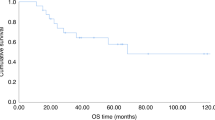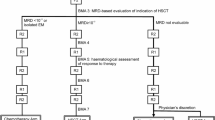Abstract
Refractory or relapsed acute myeloid leukemia (R/R AML) remains the major challenge of AML treatment. Allogeneic hematopoietic stem cell transplantation (allo-HSCT) is the only valid option to achieve cure, but the prognosis is still dismal. We conducted a retrospective analysis for the feasibility of CLAG regimens (cladribine, cytarabine, and granulocyte colony-stimulating factor) combined with total body irradiation (TBI) as new intensive conditioning chemotherapy prior to HSCT in R/R AML. A total of 70 patients, including 21 primary refractory and 49 relapsed AML, were analyzed. Forty-nine (70%) patients had extramedullary diseases, and 54 (77%) patients received haploidentical transplantation. Except for one who died before white blood cell engraftment, all of the 69 evaluable patients achieved measurable residual disease (MRD) negative complete remission. The 3-year overall survival (OS) and relapse-free survival (RFS) rates were 46.0% (95% confidence interval [CI], 33.5–57.7%) and 38.5% (95%CI, 26.8–50.0%). The 1-year cumulative incidences of relapse and non-relapse mortality (NRM) were 38.6% (95%CI, 27.3–49.3%) and 11.6% (95%CI: 5.4–20.3%), respectively. The presence of chronic graft-versus-host disease (cGVHD) showed a trend to be associated with a lower risk of relapse (P = 0.054) and extramedullary diseases with a higher risk of NRM (P = 0.074). Multivariate analyses identified low leukemia burden pre-HSCT (defined as bone marrow blasts ≤ 50%) and cGVHD as independent factors associated with favorable OS and RFS. In conclusion, intensive conditioning with CLAG regimens plus TBI may be an effective and well-tolerated choice for R/R AML patients undergoing allo-HSCT.


Similar content being viewed by others
Data availability
The data that support the findings of this study are available on request from the corresponding author.
References
Juliusson G, Hough R (2016) Leukemia. Prog. Tumor Res 43:87–100
Thol F, Ganser A (2020) Treatment of relapsed acute myeloid leukemia. Curr Treat Options Oncol 21(8):66
Thol F, Schlenk RF, Heuser M et al (2015) How I treat refractory and early relapsed acute myeloid leukemia. Blood 126(3):319–327
Schlenk RF, Dohner K, Mack S et al (2010) Prospective evaluation of allogeneic hematopoietic stem-cell transplantation from matched related and matched unrelated donors in younger adults with high-risk acute myeloid leukemia: German-Austrian trial AMLHD98A. J Clin Oncol 28(30):4642–4648
Duval M, Klein JP, He W et al (2010) Hematopoietic stem-cell transplantation for acute leukemia in relapse or primary induction failure. J Clin Oncol 28(23):3730–3738
Mohamed Jiffry MZ, Kloss R, Ahmed-Khan M et al (2023) A review of treatment options employed in relapsed/refractory AML. Hematology 28(1):2196482
Robak T (2003) Purine nucleoside analogues in the treatment of myleoid leukemias. Leuk Lymphoma 44(3):391–409
Martin MG, Welch JS, Augustin K et al (2009) Cladribine in the treatment of acute myeloid leukemia: a single-institution experience. Clin Lymphoma Myeloma 9(4):298–301
Wang L, Xu J, Tian X et al (2019) Analysis of efficacy and prognostic factors of CLAG treatment in Chinese patients with refractory or relapsed acute myeloid leukemia. Acta Haematol 141(1):43–53
Bao Y, Zhao J, Li ZZ (2018) Comparison of clinical remission and survival between CLAG and FLAG induction chemotherapy in patients with refractory or relapsed acute myeloid leukemia: a prospective cohort study. Clin Transl Oncol 20(7):870–880
Xu J, Lv TT, Zhou XF et al (2018) Efficacy of common salvage chemotherapy regimens in patients with refractory or relapsed acute myeloid leukemia: a retrospective cohort study. Medicine (Baltimore) 97(39):e12102
Luger SM, Ringden O, Zhang MJ et al (2012) Similar outcomes using myeloablative vs reduced-intensity allogeneic transplant preparative regimens for AML or MDS. Bone Marrow Transplant 47(2):203–211
Ringden O, Labopin M, Ehninger G et al (2009) Reduced intensity conditioning compared with myeloablative conditioning using unrelated donor transplants in patients with acute myeloid leukemia. J Clin Oncol 27(27):4570–4577
Leukemia & Lymphoma Group, Chinese Society of Hematology, Chinese Medical Association (2021) Chinese guidelines for the diagnosis and treatment of relapsed/refractory acute myelogenous leukemia. Zhonghua Xue Ye Xue Za Zhi 42(8):624–627
Huang XJ, Liu DH, Liu KY et al (2006) Haploidentical hematopoietic stem cell transplantation without in vitro T-cell depletion for the treatment of hematological malignancies. Bone Marrow Transplant 38(4):291–297
Schuurhuis GJ, Heuser M, Freeman S et al (2018) Minimal/measurable residual disease in AML: a consensus document from the European LeukemiaNet MRD Working Party. Blood 131(12):1275–1291
Austin PC, Fine JP (2017) Practical recommendations for reporting Fine-Gray model analyses for competing risk data. Stat Med 36:4391–4400
Dohner H, Estey E, Grimwade D et al (2017) Diagnosis and management of AML in adults: 2017 ELN recommendations from an international expert panel. Blood 129(4):424–447
Roboz GJ, Rosenblat T, Arellano M et al (2014) International randomized phase III study of elacytarabine versus investigator choice in patients with relapsed/refractory acute myeloid leukemia. J Clin Oncol 32(18):1919–1926
Kopinska A, Weglarz P, Koclega A et al (2023) Allogeneic hematopoietic stem cell transplantation for relapsed/refractory acute myeloid leukemia: a single-centre experience. Clin Lymphoma Myeloma Leuk 23(1):28–39
Todisco E, Ciceri F, Oldani E et al (2013) The CIBMTR score predicts survival of AML patients undergoing allogeneic transplantation with active disease after a myeloablative or reduced intensity conditioning: a retrospective analysis of the Gruppo Italiano Trapianto Di Midollo Osseo. Leukemia 27(10):2086–2091
Steckel NK, Groth C, Mikesch JH et al (2018) High-dose melphalan-based sequential conditioning chemotherapy followed by allogeneic haematopoietic stem cell transplantation in adult patients with relapsed or refractory acute myeloid leukaemia. Br J Haematol 180(6):840–853
Bonifazi F, Pavoni C, Peccatori J et al (2022) Myeloablative conditioning with thiotepa-busulfan-fludarabine does not improve the outcome of patients transplanted with active leukemia: final results of the GITMO prospective trial GANDALF-01. Bone Marrow Transplant 57(6):949–958
Spurgeon S, Yu M, Phillips JD et al (2009) Cladribine: not just another purine analogue? Expert Opin Investig Drugs 18(8):1169–1181
Freyer CW, Gupta N, Wetzler M et al (2015) Revisiting the role of cladribine in acute myeloid leukemia: an improvement on past accomplishments or more old news? Am J Hematol 90(1):62–72
Chow KU, Boehrer S, Napieralski S et al (2003) In AML cell lines Ara-C combined with purine analogues is able to exert synergistic as well as antagonistic effects on proliferation, apoptosis and disruption of mitochondrial membrane potential. Leuk Lymphoma 44(1):165–173
Sun Y, Zhang J, Long B et al (2021) A novel intensive conditioning regimen for allogeneic hematopoietic stem cell transplantation in the treatment of relapsed/refractory acute myeloid leukemia. Neoplasma 68(6):1351–1358
Wang J, Zhao J, Fei X et al (2018) A new intensive conditioning regimen for allogeneic hematopoietic stem cell transplantation in patients with refractory or relapsed acute myeloid leukemia. Medicine (Baltimore) 97(17):e0228
Oyekunle AA, Kroger N, Zabelina T et al (2006) Allogeneic stem-cell transplantation in patients with refractory acute leukemia: a long-term follow-up. Bone Marrow Transplant 37(1):45–50
Hosing C, Saliba RM, Shahjahan M et al (2005) Disease burden may identify patients more likely to benefit from second allogeneic hematopoietic stem cell transplantation to treat relapsed acute myelogenous leukemia. Bone Marrow Transplant 36(2):157–162
Michallet M, Thomas X, Vernant JP et al (2000) Long-term outcome after allogeneic hematopoietic stem cell transplantation for advanced stage acute myeloblastic leukemia: a retrospective study of 379 patients reported to the Societe Francaise de Greffe de Moelle (SFGM). Bone Marrow Transplant 26(11):1157–1163
Funding
This work was supported by China Capital Characteristic Clinic Project (Grant No. Z211100002921037) to **gbo Wang.
Author information
Authors and Affiliations
Contributions
X.F. and J.W. conceived and designed the study. X.F. drafted the manuscript. X.F., W.Z., J.G., F.Y., T.L., W.W., and J.W. collected and analyzed the data, and revised the final version of the manuscript. All authors approved the final version of the manuscript.
Corresponding author
Ethics declarations
Ethics approval
This study was approved by the Biomedical Ethics Committee of Aerospace Center Hospital and performed in accordance with the Helsinki Declaration.
Patient approval statement
Written informed consent was obtained from all patients in this study.
Conflicts of interest
The authors declare no competing interests.
Additional information
Publisher's Note
Springer Nature remains neutral with regard to jurisdictional claims in published maps and institutional affiliations.
Supplementary Information
Below is the link to the electronic supplementary material.
Rights and permissions
Springer Nature or its licensor (e.g. a society or other partner) holds exclusive rights to this article under a publishing agreement with the author(s) or other rightsholder(s); author self-archiving of the accepted manuscript version of this article is solely governed by the terms of such publishing agreement and applicable law.
About this article
Cite this article
Fei, X., Zhang, W., Gu, J. et al. CLAG combined with total body irradiation as intensive conditioning chemotherapy prior to allogeneic hematopoietic stem cell transplantation in patients with refractory or relapsed acute myeloid leukemia. Ann Hematol 103, 241–249 (2024). https://doi.org/10.1007/s00277-023-05502-0
Received:
Accepted:
Published:
Issue Date:
DOI: https://doi.org/10.1007/s00277-023-05502-0




